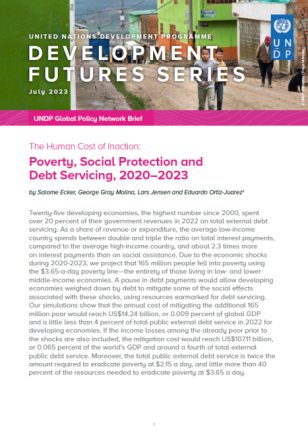The Human Cost of Inaction: Poverty, Social Protection and Debt Servicing, 2020–2023

The Human Cost of Inaction: Poverty, Social Protection and Debt Servicing, 2020-2023
pdf (1MB)
DownloadThe Human Cost of Inaction: Poverty, Social Protection and Debt Servicing, 2020–2023
July 17, 2023
Twenty-five developing economies, the highest number since 2000, spent over 20 percent of their government revenues in 2022 on total external debt servicing. The average low-income country spends about 2.3 times more on interest payments than on social assistance. Due to the economic shocks during 2020-2023, we project that 165 million people fell into poverty using the $3.65-a-day poverty line —the entirety of those living in low- and lower-middle-income economies. A pause in debt payments would allow developing economies weighed down by debt to mitigate some social effects of these shocks, using resources earmarked for debt servicing. This policy brief presents simulations that show that the annual cost of mitigating the additional 165 million poor would reach US$14.24 billion, or 0.009 percent of global GDP and a little less than 4 percent of total public external debt service in 2022 —if the income losses among the already poor prior to the shocks are also included, the mitigation cost would reach US$107.11 billion, or 0.065 percent of the world’s GDP and around a fourth of total external public debt service.

 Locations
Locations